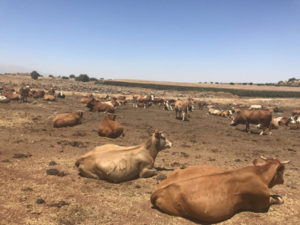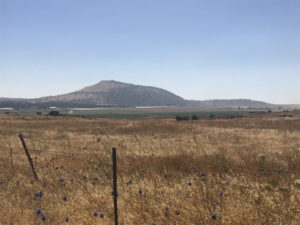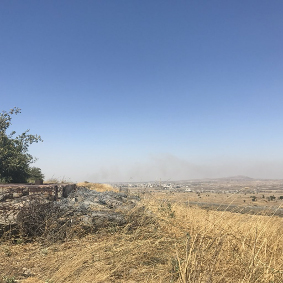Dogs, Cows and Wolves: Security on the Golan Heights
On the Golan Heights in the hills separating Syria and Israel fields of cows graze and sleep, swishing their tails, whisking off flies. Many of the cows lying in the fields appear to be waiting and contemplating as cows do. The cows are a source of milk and of meat and income for a kibbutz nearby. Among the cows wander white dogs. It is a peaceful scene except for the distant thudding and booming of the war in Syria just a mile away.

But at night wolves come out. The dogs and an occasional cowboy are the cows’ main defense. The wolves need to eat too, and a cow just standing there, especially if separated from the herd, is a natural target. The wolves are sleek and fast, and the cowboys respect them.
Sometimes the wolves score, but more often the dogs bark and circle, and the cows bellow. Dogs and cows together hold their own, and the wolves have to look elsewhere for food. Twenty years ago the cowboys determined that if they placed pups in with the cows from birth until they were 10 months old, the dogs would naturally identify with and want to protect the cows. If there are enough dogs, they can dissuade the wolves. The scheme seems to be working, but it is a standoff and not the same as peaceful coexistence.
This drama has played out with theme and variation over the past 50 years since the Golan Heights were occupied by Israel after the Six-Day War in 1967. Israel’s offer to return the Golan in exchange for peace with Syria was rejected then, and Syria attacked in the 1973 Yom Kippur war and was defeated. At present Israel occupies two-thirds of the hills of the Golan which overlooks the Jordan Rift Valley and contains the Sea of Galilee and the Jordan River. The Golan includes volcanic fields with dark volcanic rock and lighter limestone rocks. Fruit trees, particularly apples, grow there. The area overlooks Israel which sees the Golan as a natural defense line that secures its border with Syria. Between the two countries lies a small demilitarized zone monitored by the United Nations.

As the Syrian war turns yet another corner with the recent ceasefire, the Russians (and potentially by association Hezbollah and the Iranians) are now sanctioned to patrol and come within a mile of the Israeli border. Tension is again heightening. The border itself is protected by small fences and bunkers, but now on higher alert by the Israeli Army and those in the Reserves who tend the cows and pick the apples in times of peace.

Joanne your article has spelled out the current situation in Golan Heights, I could never dream of visiting that part of the globe, you brought me there with this article, I appreciate and thank you much Joanne.
Peace can only be a dream in that part of the globe, and dream can come true!!!
My heart hurts when I think of the danger the people live through every day in Israel.I wonder if it will ever end.My Granddaughter was there several years ago and was amazed with the courage these people have.
A wonderful “peace” Joanne. I love the photo of the cows. The tranquil and peaceful scene belies the dangers that lurk all around.
How wonderfully – and weirdly – peaceful on the frontlines!
I happen to tour the Golan Heights quite often, on assignment and beyond. The mixture of a peaceful, quiet scenery on the outset with the fears, anxieties and atrocities that threaten it is genuine.
Joanne, your firsthand description of the land and its animals in that one place says much about our world today.